Japan Anti-Caking Market Size
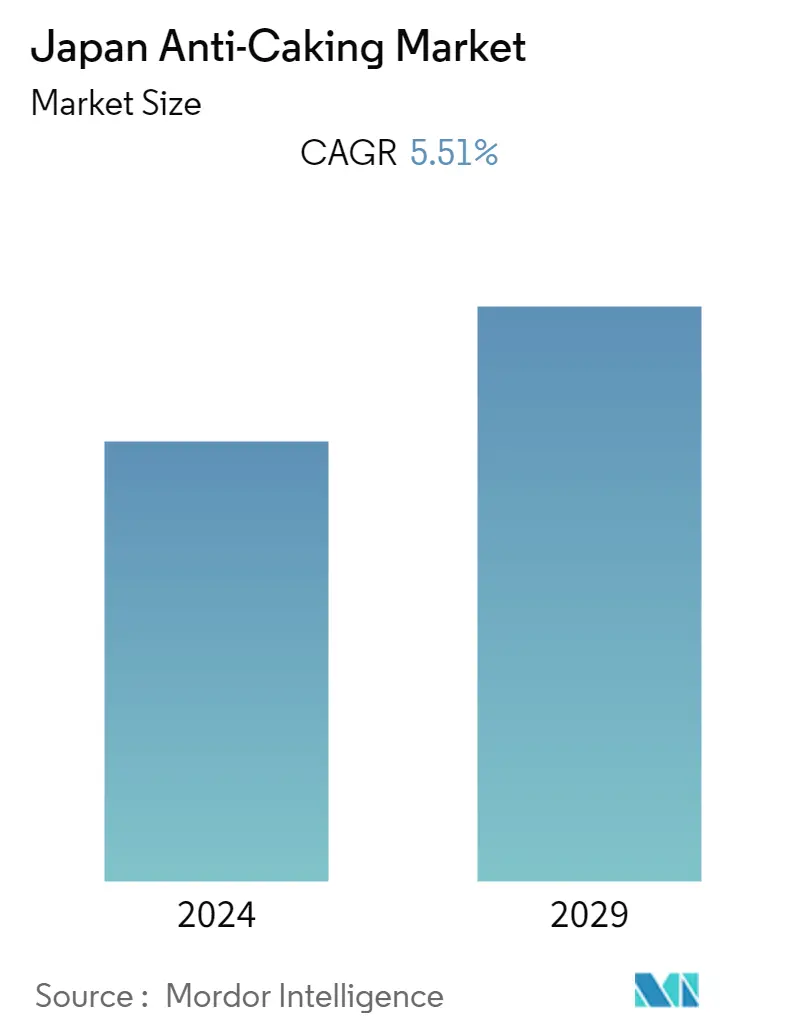
| Study Period | 2019 - 2029 |
| Base Year For Estimation | 2023 |
| Forecast Data Period | 2024 - 2029 |
| Historical Data Period | 2019 - 2022 |
| CAGR | 5.51 % |
| Market Concentration | Low |
Major Players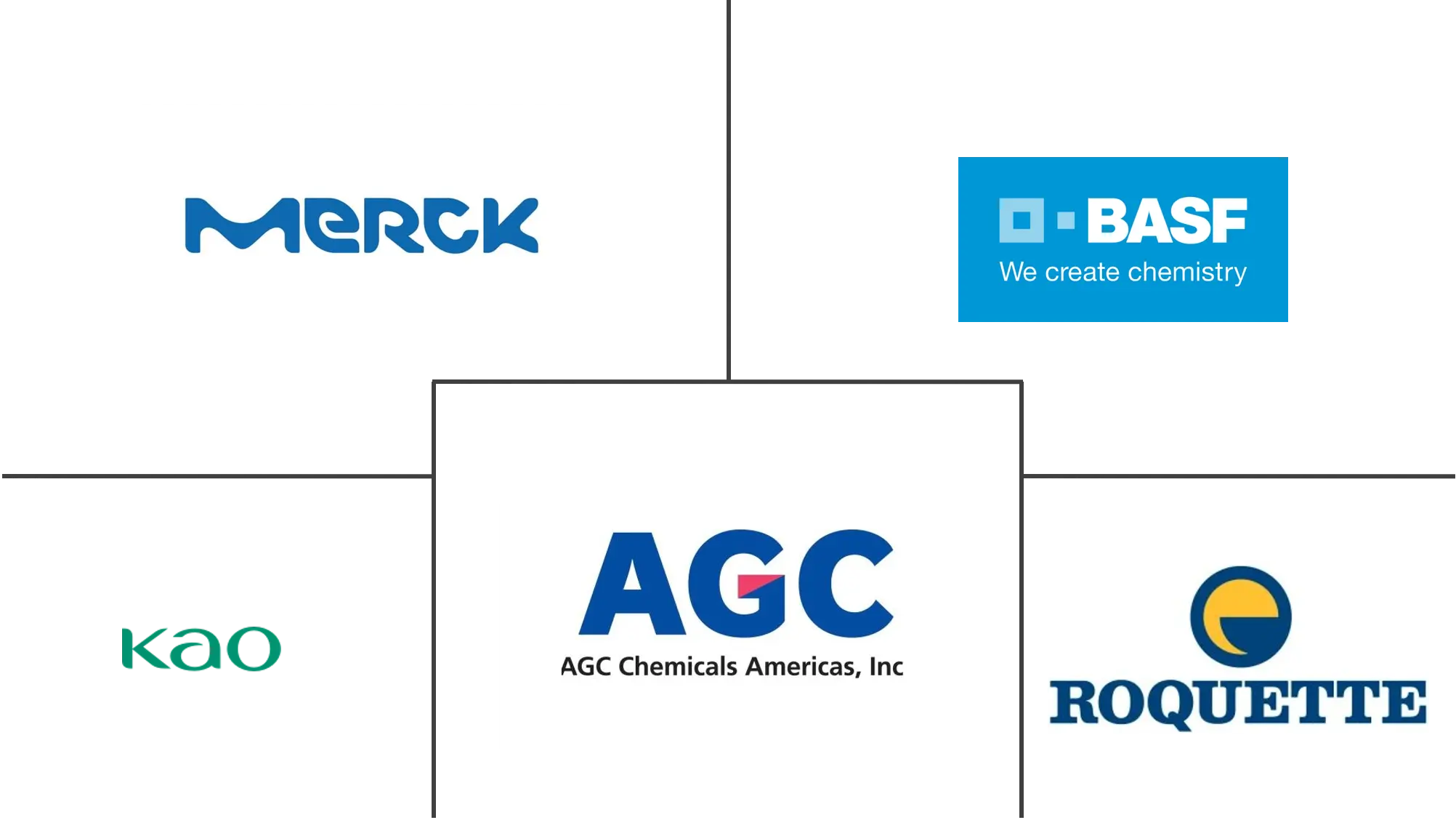
*Disclaimer: Major Players sorted in no particular order |
Japan Anti-Caking Market Analysis
The Japanese anti-caking market is projected to witness a CAGR of 5.51% during the forecast period, 2020 - 2025.
- Robust consumer market persisting in Japan has been a primary reason boosting the additives market in the country, including the sale of anti-caking agents. The availability of raw materials and the new technological advancements are other factors resulting in the growth of the anti-caking agent market in the country.
- Manufacturers, in order to prevent the formation of lumps in powdered products, across the applications, like detergents, coffee, cement, feed, etc., are incorporating anti-caking agents, during formulations. This is leading to an increased demand for the market studied in the country.
Japan Anti-Caking Market Trends
This section covers the major market trends shaping the Japan Anti-Caking Market according to our research experts:
Growing Market for Processed Food
Some of the common examples of foods that contain anti-caking agents include coffee, cocoa, soup powders, milk and cream powders, grated cheese, icing sugar, baking powder, cake mixes, drinking chocolate, table salt, and canned fruits and vegetables as a firming agent. There are opportunities for growth from the emerging markets of Asia-Pacific, mainly due to the increasing disposable incomes from the region and consumer demand for processed food and beverage. The Japanese food industry is a saturated market, and it is looking at opportunities in the East Asian nations, and for the purpose, investigates the food practices and regulations.
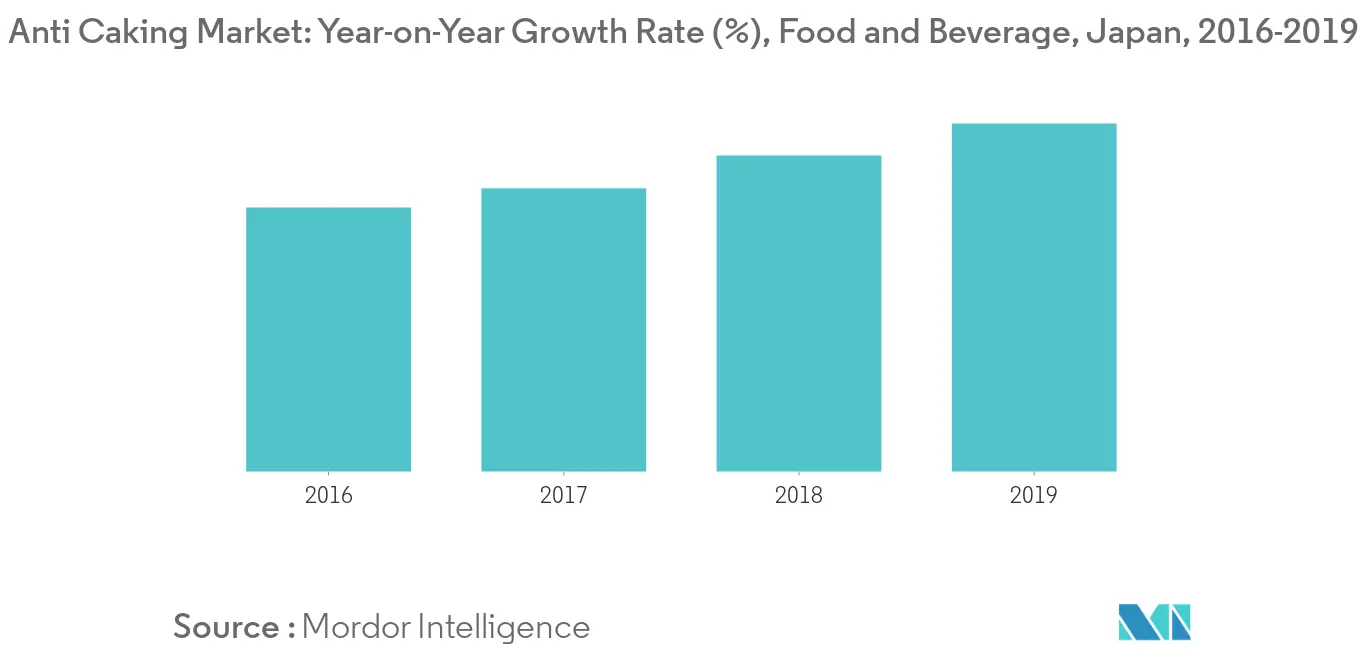
Calcium Compounds Held the Largest Market Share
Calcium compounds are extensively used in food and beverage in products, like baking powders, desserts, custard mix, etc. Calcium aluminum silicate, calcium phosphate tribasic, calcium silicate are some of the most commonly used calcium compounds. Calcium compounds function either by absorbing excess moisture or by coating particles and making them water repellent. Calcium silicate (CaSiO3), a common calcium compound anti-caking agent, which is added to table salt, absorbs both water and oil.
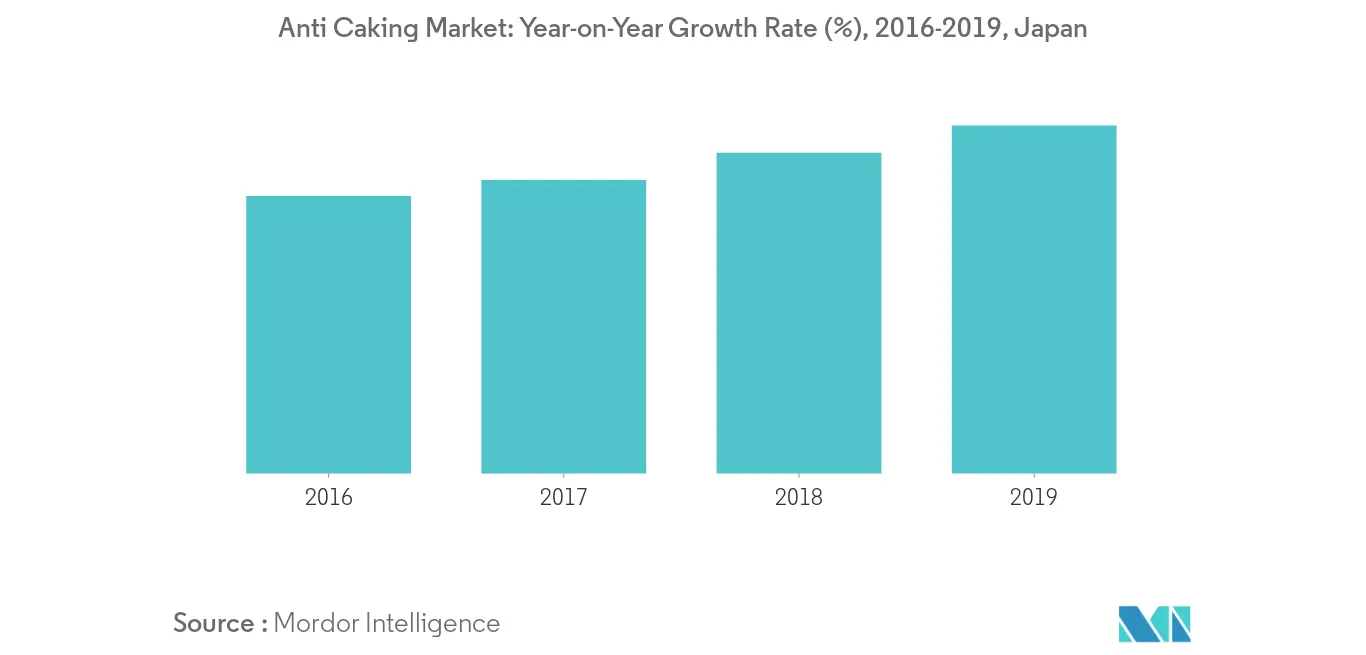
Japan Anti-Caking Industry Overview
The leading players in the anti-caking agents market include Evonik Industries AG, Merck KGaA, and Kao Corp. Companies are investing in new facilities to expand their production capacities, in order to meet the increasing demand for anti-caking agents. The major constraint being faced by the industry is the high cost for natural anti-caking agents, thus, the opportunities lie in for the manufacturers to innovate in technological advancements under the natural category.
Japan Anti-Caking Market Leaders
-
Merck KGaA
-
BASF SE
-
Kao Corporation
-
Roquette Frères
*Disclaimer: Major Players sorted in no particular order
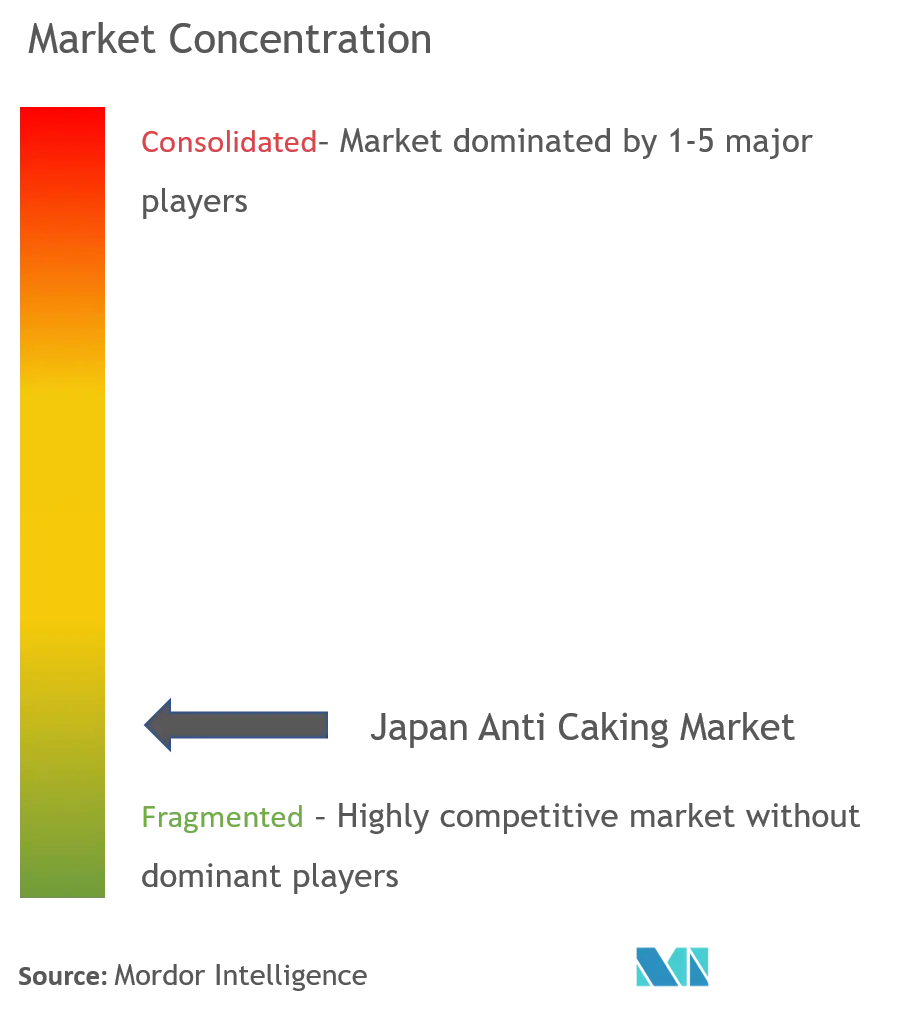
Japan Anti-Caking Market Report - Table of Contents
1. INTRODUCTION
- 1.1 Study Assumptions and Market Definition
- 1.2 Scope of the Study
2. RESEARCH METHODOLOGY
3. EXECUTIVE SUMMARY
4. MARKET DYNAMICS
- 4.1 Market Drivers
- 4.2 Market Restraints
-
4.3 Industry Attractiveness - Porter's Five Forces Analysis
- 4.3.1 Threat of New Entrants
- 4.3.2 Bargaining Power of Buyers/Consumers
- 4.3.3 Bargaining Power of Suppliers
- 4.3.4 Threat of Substitute Products
- 4.3.5 Intensity of Competitive Rivalry
5. MARKET SEGMENTATION
-
5.1 Type
- 5.1.1 Calcium Compounds
- 5.1.2 Sodium Compounds
- 5.1.3 Magnesium Compounds
- 5.1.4 Other Types
-
5.2 Application
- 5.2.1 Food and Beverage
- 5.2.1.1 Bakery Products
- 5.2.1.2 Dairy Products
- 5.2.1.3 Soups and Sauces
- 5.2.1.4 Beverage
- 5.2.1.5 Other Food and Beverage
- 5.2.2 Cosmetic and Personal Care
- 5.2.3 Feed
- 5.2.4 Other Applications
6. COMPETITIVE LANDSCAPE
- 6.1 Most Adopted Strategies
- 6.2 Market Position Analysis
-
6.3 Company Profiles
- 6.3.1 Merck KGaA
- 6.3.2 BASF SE
- 6.3.3 Kao Corporation
- 6.3.4 Roquette Freres
- 6.3.5 AGC Chemicals
- 6.3.6 Evonik Industries AG
- *List Not Exhaustive
7. MARKET OPPORTUNITIES AND FUTURE TRENDS
** Subject To AvailablityJapan Anti-Caking Industry Segmentation
The Japanese anti-caking market is segmented into calcium compounds, sodium compounds, magnesium compounds, and others. The study also includes revenue generated through food and beverage, cosmetic and personal care, feed, and others.
| Type | Calcium Compounds | |
| Sodium Compounds | ||
| Magnesium Compounds | ||
| Other Types | ||
| Application | Food and Beverage | Bakery Products |
| Dairy Products | ||
| Soups and Sauces | ||
| Beverage | ||
| Other Food and Beverage | ||
| Application | Cosmetic and Personal Care | |
| Feed | ||
| Other Applications |
Japan Anti-Caking Market Research FAQs
What is the current Japan Anti-Caking Market size?
The Japan Anti-Caking Market is projected to register a CAGR of 5.51% during the forecast period (2024-2029)
Who are the key players in Japan Anti-Caking Market?
Merck KGaA, BASF SE , Kao Corporation and Roquette Frères are the major companies operating in the Japan Anti-Caking Market.
What years does this Japan Anti-Caking Market cover?
The report covers the Japan Anti-Caking Market historical market size for years: 2019, 2020, 2021, 2022 and 2023. The report also forecasts the Japan Anti-Caking Market size for years: 2024, 2025, 2026, 2027, 2028 and 2029.
Japan Anti-Caking Industry Report
Statistics for the 2024 Japan Anti-Caking market share, size and revenue growth rate, created by Mordor Intelligence™ Industry Reports. Japan Anti-Caking analysis includes a market forecast outlook to 2029 and historical overview. Get a sample of this industry analysis as a free report PDF download.



